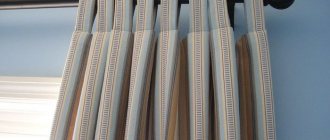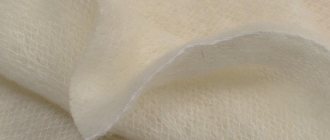Fixing the braid with loops to the curtains is one of the most critical stages of work when sewing curtains. The final appearance of the fabric depends on the correctness and quality of sewing: the quantity, depth and intensity of drapery, the length of the finished product, even the type of cornice. Using a strip of fabric above the loops, you can hide an ugly and unaesthetic fastening, and the curtain fabric will look like it is floating in the air under the ceiling.
Curtain tape
Such work in the studio is not cheap, so if you sew loops on the curtains with your own hands, you can save a decent amount. The main thing is to calculate your own strengths and skills. If in doubt, practice on country curtains. As a last resort, do not take risks - trust the professionals (especially when it comes to processing expensive and difficult-to-work fabrics).
What is curtain tape
Curtain tape is a braid with loops located on one side. Two cords run through the entire length of the braid. They are designed to tighten the already sewn tape. Cords allow you to form beautiful folds on curtains. At the same time, they are fixed and the curtain does not need to be arranged figuratively every time you close it.
In the photo of the curtain tape you can see that it comes in different widths and there can also be several rows of loops into which the hooks are inserted. Typically, the width of the tape is proportional to the weight of the curtain. The heavier the curtains on the curtain tape, the wider the tape must be to support the weight of the product.
The number of rows of loops allows you to adjust the height of the curtain from the floor and from the cornice. If your tape has two rows of loops, hooks can be inserted into the top one to lower the curtain and into the bottom one to raise it above the floor level.
Wide ribbons allow you to cover the hooks. If you insert them into the bottom row of loops, the pleated top of the curtains will hide the hooks and the curtain will be adjacent to the curtain rod pipe.
Curtain tape can be sewn not only along the top edge of the curtain, but also in any other place. For example, to form soft folds for decorative drapery.
In addition to the rows for attaching hooks, there may be a Velcro strip at the bottom of the tape. It is designed to be attached to tulle curtains. The tulle is glued to the Velcro and then there is no need to sew a separate tape on it and order a cornice with two pipes. Both layers of textile are attached to one classic cornice.
Tips from an experienced seamstress
The following advice from an experienced craftswoman will help you sew the ribbon to the curtains correctly and avoid the need for rework:
- 2 threads are threaded into the machine: colored, suitable for curtains, and white;
- to prevent shrinkage, it is advisable to wet the curtain fabric and tape before use in warm water and dry it;
- It is better to hem all sections of fabric. If the braid is hemmed inside out, the top cut of the curtain fabric will be inside the hem. In this case, to prevent thread spillage, you can simply overcast it;
- before sewing the ribbon, you should definitely check for loops on the desired side, because there is always a risk of sewing it incorrectly;
- so that the free ends of the ropes after draping do not spoil the overall appearance of the curtain, they are hidden in secret pockets on the inside of the curtain;
- if for a ribbon 1.5–2 cm wide, 2 lines are enough - at the top and bottom, then for wider ones you will need 3–4;
- It is not necessary to secure the thread at the end of each line. At the end of the work, they can simply be assembled into one unit.
The ends of the cords are hidden in a pocket
Types of assemblies
In addition to the classic “accordion”, hanging curtains can form a wide variety of folds. Depending on the placement of the cords, there are the following folds:
- "Pencil". Narrow triangle folds are formed on the curtain, turning into wide rectangles, similar in shape to pencils;
- “One-sided”, when all the folds are laid in one direction;
- “Two-sided”, when the folds of up to half of the curtain are directed in one direction, and the second half is turned first towards;
- “Butterflies” are wide rhombuses diverging to the sides;
- "Glasses." Each fold is shaped like an hourglass;
- "Cases." Wide rectangular folds of equal width are formed on the curtain;
- "Bud". The fold shape is similar to the "Glass" but the bottom part tapers. It turns out to be a flower on a stalk;
- "French". The folds form the letter "X";
Before hemming curtains with tape, find out the gathering factor of the selected tape. It can be from 1.5 to 3. This indicator is indicated on the packaging of the tape. You need to multiply the width of the cornice by this factor to buy curtains of the required width.
Fringe for a formal occasion
Curtains made from high-quality textiles can radically change the interior of a room. They add notes of solemnity and presentability to the design, elevating even the simplest furnishings of the room. Fringe is a decorative element that greatly enhances the visual appeal of the window design.
There is a variety of fringe on the market, differing in the material of manufacture, size, color and the use of additional accessories. It is not difficult to choose the appropriate decor for any curtains - from light curtains made of silk and satin, to curtains made of dense fabrics - jacquard, velvet.
Among the interiors in which fringed curtains are appropriate, we highlight the following stylistic trends:
- Victorian style;
- Classic;
- Modern;
- Baroque;
- Provence;
- Empire style
In interiors decorated in modern styles - minimalism, fusion, hi-tech, loft, fringe on the curtains looks alien, since their philosophy does not imply an emphasis on the solemnity of the atmosphere.
Photos of curtain tapes
We distinguish varieties
A store consultant will definitely help you choose the optimal tape, but it’s better to study the varieties offered before going to the shopping center. Thus, curtain braid is used for hemming curtains and for processing their upper part.
In the latter case, there are several types of ribbon, differing in the type of folds: “column”, “zigzag”, “butterfly”, “bow”, “tube”, “tulip”, “triplets”, “buffe” and others.
Strips for heavy fabrics are selected separately.











